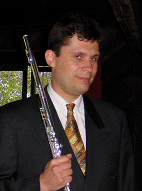

Arnold Schönberg
b. 1874 Vienna, Austria; d. 1951 Brentwood, California
b. 1874 Vienna, Austria; d. 1951 Brentwood, California
|
Three Pieces, Op. 11, (1909) Debate continues into the current century as to whether Arnold Schönberg’s more significant contribution to 20th Century music was the music he composed or the considerable influence he had, as a teacher and innovator, on so many composers and musicians of the past century. Patriarch, along with pupils Alban Berg and Anton Webern, of what has become known as the “Second Viennese School,” Schönberg was essentially self-taught in music, and his musical ideas, theories, and techniques continually changed and evolved throughout his lifetime. Schönberg’s early compositions remained essentially “Viennese Romantic” in style, derivative of Brahms, Wagner, and Hugo Wolf. He made his “break with the past” and entered a new phase of composition with the “Three Pieces,” which were the first atonal pieces to be published. Copies of the manuscript were sent to pianist–composer–pedagogue Ferruccio Busoni in the hope of having them performed, but Busoni objected not only to their abandonment of traditional tonal harmony but also to their compact piano writing. Busoni wrote his own version of the second piece of the set, thus showing Schönberg how to write a more acceptable piece by lengthening the phrases through repetition and through the use of the pedals. Schönberg objected to both aims and proclaimed that he had “invented a new style of piano writing” in these compositions. Both versions of the second piece, Schönberg’s and Busoni’s, were published at the same time in 1910. Although the harmony of these pieces avoids any tonal center, the densely referential thematic material binds them into a coherent and powerful whole. Marckus Thorensen FHMD-2004 |